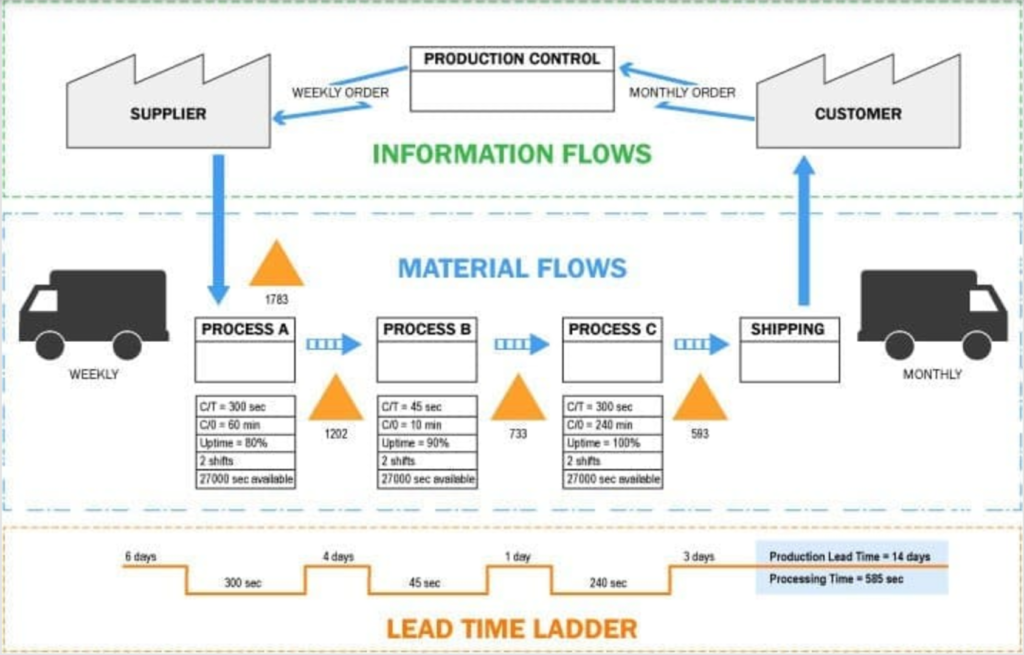Every company needs to find ways to improve its processes and leverage growth. For that, it is necessary to understand exactly how the operation works and what are the activities that add more to the business. In this sense, the Value Stream Mapping is essential to visualize the necessary steps for the delivery of a product.
What is Value Stream Mapping?
Also known as VSM (acronym for Value Stream Mapping), Value Stream Mapping is a flowchart tool to point out, illustrate, analyze and quantify the processes within a company, in order to identify which activities generate greater added value and which ones generate little value.
In this way, it is possible to find where the main sources of waste are and start a program of continuous improvement.
It is important to highlight that VSM differs from process mapping, since the latter is simpler and done without taking into account the flow of information and materials. On the other hand, VSM is more aligned with the lean culture and identifies more clearly which activities generate more or less value within the productive sector.
How to apply Value Stream Mapping?
The first step in putting VSM into practice is to identify the product or product family that will be analyzed and the boundaries of the map (where it should start and end). It is important to have the support of the company’s leadership as you will need time and often relevant data straight from the shop floor.
From then on, the process design really enters, which can be divided into the following steps:
1- Definition of process steps
Within the established limit, define the steps that take place in a single location, where the stock enters and then leaves. Remember that, unlike what happens in process mapping, here you are not listing each task that is performed, but studying the work activities and information flow that add value.
2- Data collection
With the steps outlined, it’s time to evaluate the performance of each process. This information should be added to a “data box” when drawing the map. It is data such as stock size, cycle time, OEE, number of employees and any other information that will be decisive to add value or not to the customer.
3- Evaluation of steps
At this point, you need to analyze whether each step of the process is valuable (generates value from the customer’s perspective), capable (what is the frequency of a good result in each cycle), available (if that task is constantly available), adequate (if there is the capacity to meet all customer demands) and flexible (how quickly the process can change and without losses).
4- Mapping the movement and flow of information
Also record the flow of information and movement of materials within the operation. The ideal is that the product never stops moving, which can be verified by the level of stocks. It is also necessary to understand how the information flows, analyzing the points of contact with suppliers and customers.
5- Map analysis
Locate where the main wastes are, points that can be improved, processes that do not add value and can be reduced or eliminated. From there, create a plan for continuous improvement and design a VSM with the future state to have a direction to follow.
Key Benefits of Value Stream Mapping
As we have already said, VSM is closely linked to Lean Manufacturing. Thus, its main benefits are the reduction of waste and the optimization of the resources available in the business.
In an increasingly competitive market, those who do not know how to get the most out of their resources will be left behind. It is worth saying that, when we talk about resources, we are including labor, machinery, equipment, materials and any other factor that can add value in the operation.
It is important that everyone involved in the business understand the importance of Value Stream Mapping to put the changes into practice and increase the company’s productivity.
How Novidá can help you
Novidá has developed an indoor geolocation system that helps you visualize the processes of your operation and include assertive data in a Value Stream Mapping.
Through badges, smartphones or tags (beacons), we monitor the movement of employees and mobile equipment within their business environment. Thus, it is possible to track the movement history, understand the execution time of each activity, locate employees in real time and much more!
Do you want to know how our system makes Value Stream Mapping much more complete and helps to optimize your business? Schedule a conversation with our experts!





